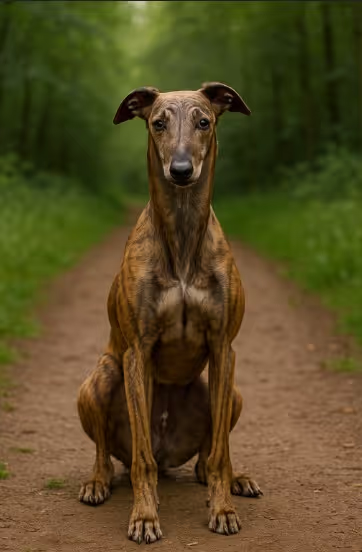The Greyhound is a sleek and graceful breed originally bred for hunting and racing. Renowned as the fastest dog in the world, it also makes a surprisingly gentle and low-maintenance companion. Despite their racing history, Greyhounds are calm and affectionate, thriving in quiet homes and adjusting well to apartment life. Known as "40-mph couch potatoes," they enjoy short bursts of energy followed by long naps.

Greyhounds are one of the oldest known dog breeds, with origins tracing back over 5,000 years to ancient Egypt. Revered for their speed and elegance, they were favored by pharaohs and later by European nobility for hunting game like deer and hares. In the 1800s, Greyhound racing gained popularity in the UK and eventually North America. Despite their athletic heritage, most retired racers adapt exceptionally well to domestic life, thanks to dedicated adoption programs that began in the 1980s.
The Greyhound is instantly recognizable by its narrow, aerodynamic head, deep chest, and long limbs built for speed. Males typically weigh between 65–70 lbs, and females 60–65 lbs. They stand 27–30 inches tall at the shoulder. Their short, fine coat comes in a wide variety of colors, including brindle, fawn, black, blue, and white. Their expressive eyes and calm demeanor give them an air of quiet nobility.
Minimal grooming is needed. A weekly once-over with a soft bristle brush or grooming mitt helps reduce light shedding and keeps their skin healthy. Greyhounds have sensitive skin that can be prone to cuts, so gentle care is important. Bathing should be infrequent unless needed. Regular nail trimming and ear cleaning are recommended every two weeks.
Contrary to popular belief, Greyhounds do not require extensive exercise. A daily 30–45 minute walk combined with occasional opportunities to sprint in a safe, enclosed space is ideal. Indoors, they are quiet and calm. Lack of exercise can lead to mild restlessness, but they rarely become destructive.
Greyhounds are intelligent but independent. Use positive reinforcement and reward-based methods to earn their trust. Harsh discipline is counterproductive due to their sensitive nature. Socialization from an early age helps them adjust to household noises and strangers. Leash training is especially important because of their natural chase instincts.
A Greyhound’s lean physique benefits from a high-quality, protein-rich diet. Kibble with real meat as the main ingredient is ideal. Adults typically require 2–3 cups of food daily, divided into two meals. Avoid high-fat treats and watch for signs of bloat, especially after exercise. Some retired racers may need supplements to rebuild muscle mass.
Greyhounds are a healthy breed but require unique care in some areas.
Common issues include:
Always ask for veterinary records and screening results, especially when adopting a retired racer.
Many Greyhounds are available for adoption after their racing careers. These dogs are usually well-socialized and crate-trained. Look for breed-specific rescues like:
If buying from a breeder, ask about early socialization, exposure to home environments, and health screenings — especially orthopedic and thyroid testing.
Are Greyhounds good for apartments?
Yes, they are surprisingly calm and quiet indoors, making them excellent apartment dogs.
Do Greyhounds get along with other dogs or cats?
They’re usually good with other dogs, especially fellow sighthounds. Some may chase small animals, so cat-testing is important during adoption.
Are Greyhounds high maintenance?
No. They require minimal grooming and moderate exercise, making them low-maintenance compared to other large breeds.
What’s the lifespan of a Greyhound?
They typically live 10–14 years with proper care and nutrition.
Can Greyhounds be left alone?
They can adapt to being alone but benefit from a structured routine. Many do best with another dog companion.